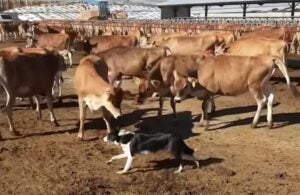Many farmers and ranchers that herd animals today tend to use people or machines, but a select few still use herding dogs. Herding dogs play just as important of a role in agriculture today as they have in the past. Using dogs to herd is an intricate partnership between the dog, the dog’s handler, and the livestock.
Herding dogs have been bred to do what they do. Many have intense, natural herding instincts and can even herd people (especially children). These dogs work to gather, herd and protect livestock. Many people use herding dogs to move cattle, sheep, goats, and even ducks and other poultry.
Different breeds of herding dogs are often used for different purposes. The best breed of dog for each operation depends on what type of livestock you have, your geographic location, and what your other goals for yourself and your dog are. Border collies are well known for staring down livestock to control them. They will occasionally nip at a particularly stubborn animal, but that is not normally a main part of their work. While they can herd any animal, they are best known for herding sheep and poultry. Australian cattle dogs, also known as Heelers, tend to follow what their name is and nip at the heels of an animal to move it. Because of this strategy, they are great for herding cattle (like their name suggests!).
Each breed may also be better for different locations. For example, the Australian Kelpie (also known as the Working Kelpie) is a common breed of herding dog from Australia that can handle extreme heat and difficult conditions.

Herding dogs make life easier for farmers and ranchers. They can take most of the manual labor out of moving livestock. Dogs allow a farmer or rancher to move an entire herd of livestock quickly and with only one person. Herding dogs can also travel places that people can’t go and do it quickly or over a great distance. For example, the Australian Kelpie is a breed known for “backing” sheep. This means they will walk or run across the backs of sheep to get to the other side of a herd quickly and efficiently. This is obviously much faster than a person trying to walk around to get to the other side of the herd. Dogs can also cover a great distance to bring livestock back to their handler.
Dogs serve as more than just a “tool” for farmers and ranchers to use — they provide companionship. They are often part of the family and serve as loyal companions to their owners. Dogs form strong bonds with their owners and work side by side with them every day as partners.
Herding dogs can also be a part of improving animal welfare. Experienced dogs are able to move livestock quietly and calmly without stressing them. Dogs can also move livestock much more quickly than people since a well-trained dog knows exactly where to place itself to get the animal to move where it wants. A young or inexperienced dog can increase the stress of livestock if they are excessively barking, herding too aggressively (putting too much pressure on the livestock), or if they are in the wrong place. This shows the importance of training. It can take a lot of work and time to get a well-trained herding dog. Each handler has to know how to read both their dog and the livestock they are herding and give the correct commands, so it can be a bit of a learning curve for both the dog and the handler.
Dogs can also make moving livestock safer for everyone involved. Since the dogs are doing a lot of the work, it allows people to stay back farther away from the livestock. Herding breeds are also incredibly intelligent and can read and react to the animals movements more quickly than a person can, keeping them out of harm’s way.
Dogs are such an important part of farm and ranch life that the American Farm Bureau has a Farm Dog of the Year contest! These dogs aren’t always herding dogs, some are amazing companions to their owners, guardian dogs that protect livestock, and more. All of them have one thing in common: They play an important role on their farm and are extremely helpful to their owners.
Herding dogs play an important role on farms and ranches around the world by moving animals quickly and efficiently, providing companionship for their owners, improving animal welfare, making moving animals safer for people, and more. Herding dogs also love their job since they are bred to do it. Herding dogs are intelligent, loyal, adaptable and versatile and serve just as crucial of a role on farms and ranches today as they have for years. Thanks to their hard work, herding dogs contribute to the success of farms and ranches around the globe!
Michelle Miller, the “Farm Babe,” is an internationally recognized keynote speaker, writer, and social media influencer and travels full time to advocate for agriculture. She comes from an Iowa-based row crop and livestock farming background and now resides on a timber farm in North Central Florida.



